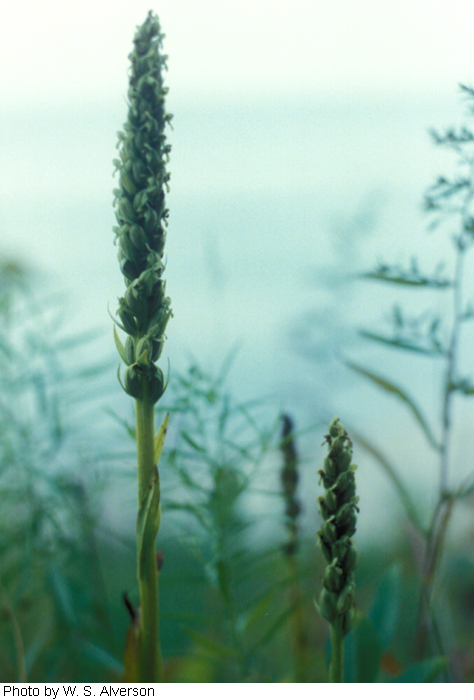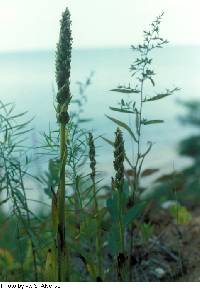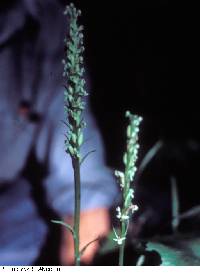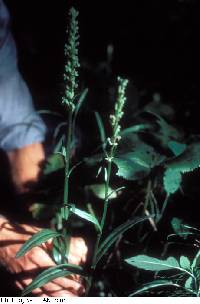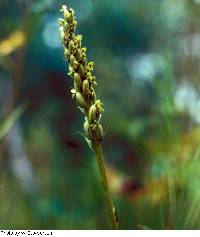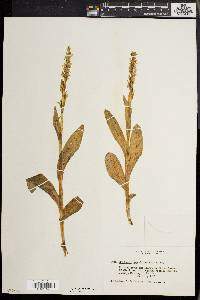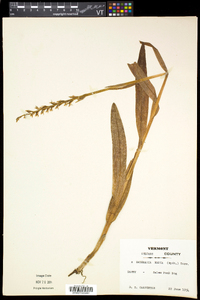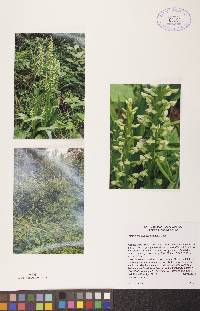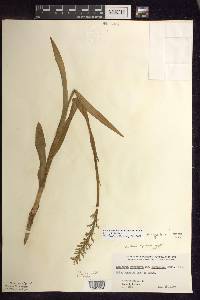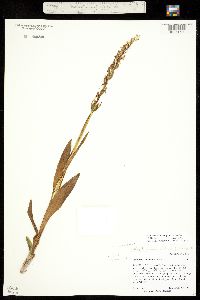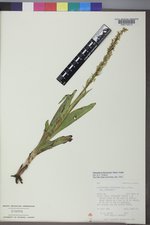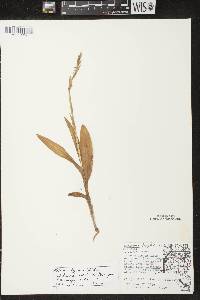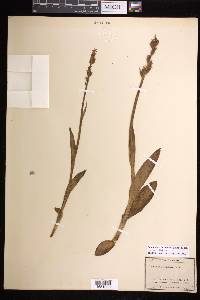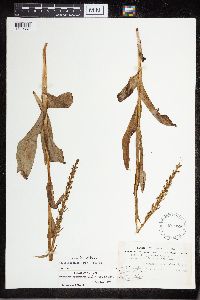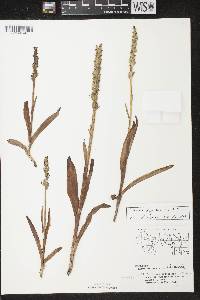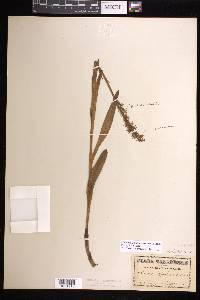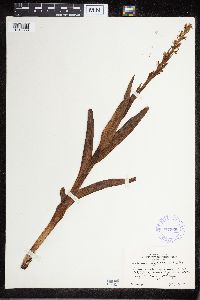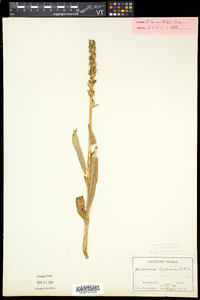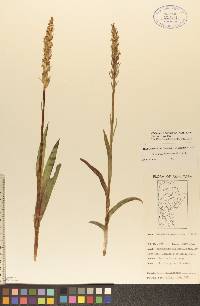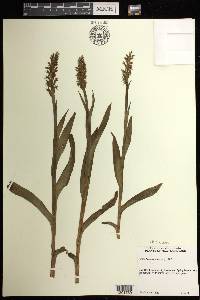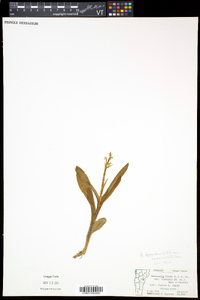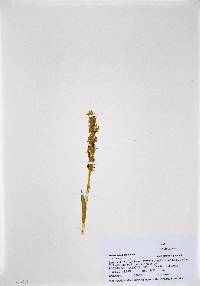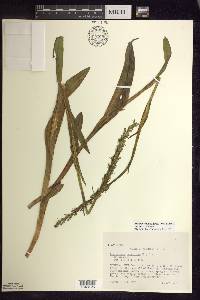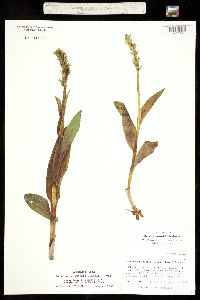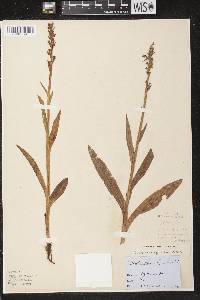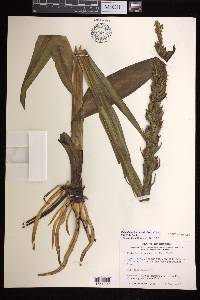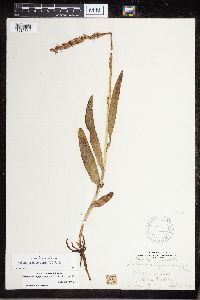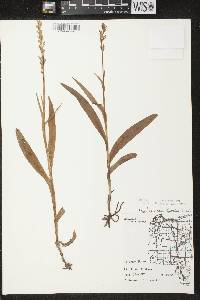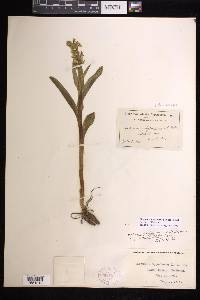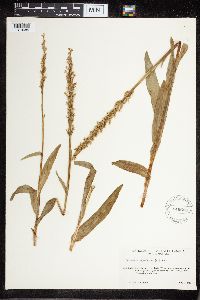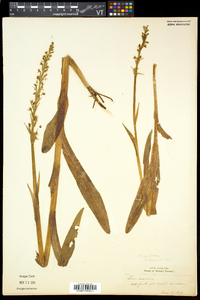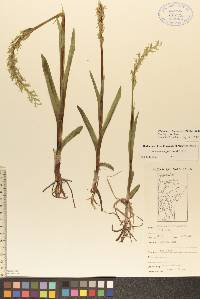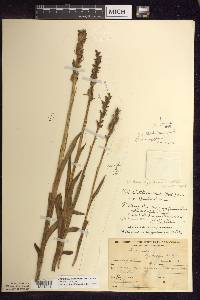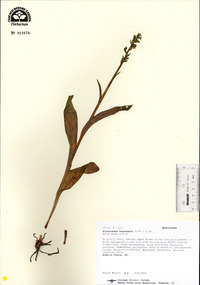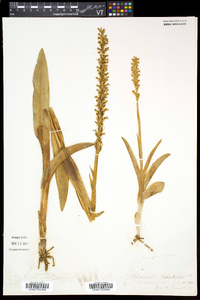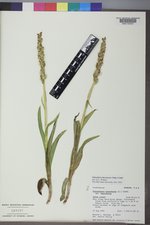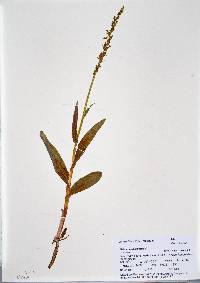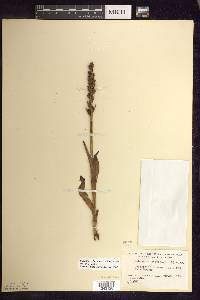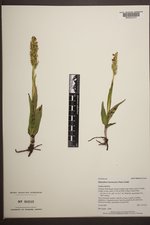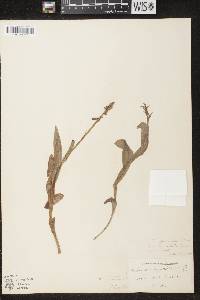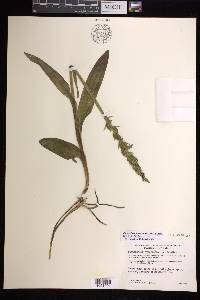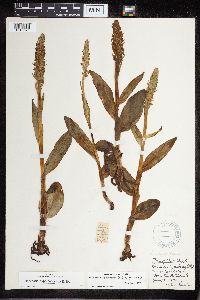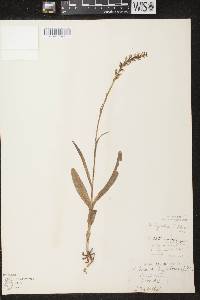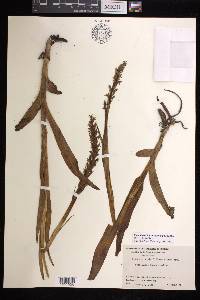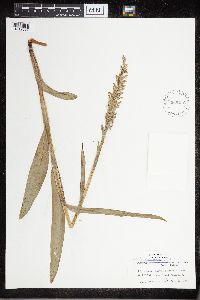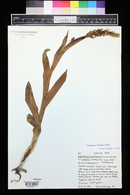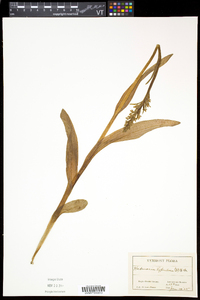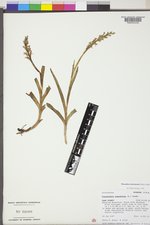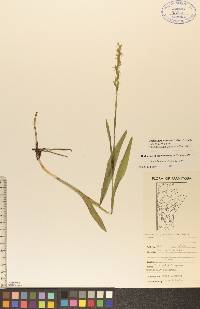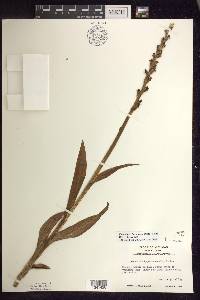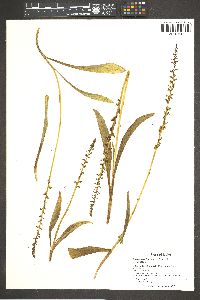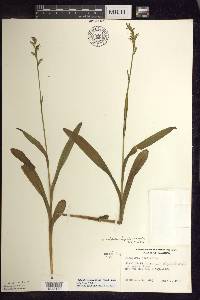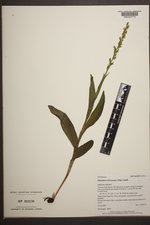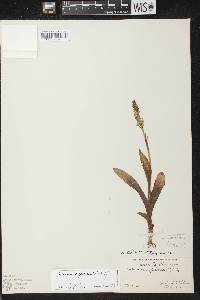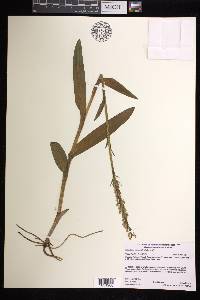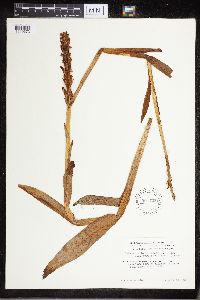Platanthera huronensis
|
Platanthera huronensis (Nutt.) Lindl.
 (redirected from: Habenaria dilatata var. media (Rydb.) Hultén) (redirected from: Habenaria dilatata var. media (Rydb.) Hultén) |
|
|
Family: Orchidaceae
Huron green orchid, more...Lake Huron Green Orchid
[Habenaria dilatata var. media (Rydb.) Hultén, moreHabenaria huronensis (Nutt.) Spreng., Habenaria hyperborea var. huronensis (Nutt.) Farw., Orchis huronensis Nutt., Platanthera hyperborea var. huronensis (Nuttall) Luer., Platanthera hyperborea var. major Lange, Platanthera media (Rydb.) Luer] |
Plants 10-100 cm or more. Leaves few-several, ascending, scattered along stem, gradually reduced to bracts distally; blade oblong to linear-lanceolate, 5-30 × 0.6-7 cm. Spikes very lax to very dense. Flowers resupinate, not showy but sometimes conspicuous, whitish green; corolla often whiter than calyx; lateral sepals spreading to slightly reflexed; petals ovate- to lance-falcate, margins entire; lip descending or apex adhering to dorsal sepal and petal apices, lanceolate to nearly linear, without basal thickening, 5-12 × 2-4 mm, base slightly to rather markedly rounded-dilated, margins entire; spur slenderly cylindric to clavate, 4-12 mm, apex usually slenderly tapered; rostellum lobes divergent, directed downward, very small, obscure, rounded; pollinaria straight; pollinia remaining enclosed in anther sacs; viscidia oblong; ovary rather slender to stout, mostly 6-15 mm. 2n = 84. Flowering Jun--Aug. Wet meadows, tundra, marshes, fens, stream banks, shores, ditches, seeping slopes, roadsides; 0--3300 m; Alta., B.C., Man., N.B., Nfld. and Labr., N.S., Ont., P.E.I., Que.,Yukon; Alaska, Colo., Conn., Idaho, Maine, Mass., Mich., Minn., Mont., N.H., N.J., N.Mex., N.Y., Oreg., R.I., S.Dak., Utah, Vt., Wash., Wis., Wyo. Northwestern plants commonly treated as Platanthera hyperborea var. viridiflora (Chamisso) Kitamura (note Kitamura´s priority over Luer) are P. huronensis; Chamisso´s name furthermore is synonymous with P. stricta. Aleutian and coastal Alaskan plants are often short, stout, and broad-leaved, and they have incorrectly been referred to 9. P. convallariifolia. Platanthera huronensis as here delimited does not auto-pollinate in the manner of P. aquilonis. Occasional plants and populations that may be referable to P. huronensis, however, exhibit the movement of pollinia typical of P. aquilonis. These plants might reflect infraspecific variation within an allotetraploid species, result from hybridization, or constitute a distinct taxon. The relationship of some of these plants to P. hyperborea needs study. Platanthera huronensis is typically intensely fragrant with the sweet, pungent scent of some related species. Platanthera huronensis is known to hybridize with P. dilatata; it may hybridize with other species as well. Although hybrids of P. dilatata and P. aquilonis may occur, the name traditionally used for them, P. ×media (Rydberg) Luer is a synonym of P. huronensis. See notes under 10. P. aquilonis and 8. P. hyperborea.
Perennial herb 10 - 100 cm tall Stem: single, erect, with scattered leaves which reduce in size gradually to bracts upward. Leaves: few to several, ascending, stalkless, green, hairless, non-toothed, 5 - 30 cm long, 0.6 - 7 cm wide, oblong to narrowly lance-shaped, gradually reduced to bracts upward. Inflorescence: a single, erect, terminal, hairless, elongate, spike-like cluster of twenty to eighty stalkless flowers with each flower subtended by an erect, lance-shaped, long-tapering pointed bract. The lower bracts of the inflorescence are longer than the flowers, and then gradually reduce in size upwards with the uppermost about the same length as the flowers. Flowers: stalkless, intensely fragrant (sweet, pungent), not showy (but sometimes conspicuous), whitish green, hairless, bilaterally symmetric with spreading lateral sepals, and center sepal and lateral petals closely positioned into high hood above lip petal, which has base modified into a nectar spur. The reproductive parts of stamens, stigma and style are fused into a column above the 0.6 - 1.5 cm long inferior ovary. Sepals: three, greenish, hairless, non-toothed, with two egg-lance-shaped, 4 - 9 mm long, 1.5 - 4 mm wide lateral sepals spreading or reflexed and curving backwards on either side of lip petal. The central, uppermost sepal, which is typically 3 - 7 mm long, 2 - 4 mm wide, almost rounded or egg-shaped, and widest near the base with a blunt tip, is erect and curves forward so the tip converges with the lateral petals, which together extend forward to form a tall, open hood over the column and above the lip petal. Fruit: several, stalkless, erect, fairly plump ellipsoid capsules subtended by ascending bracts. Lateral petals: two, whitish green, erect, curving forward over column, flanking central sepal, hairless, non-toothed, 3 - 7 mm long, 1 - 3 mm wide, egg- to lance-shaped with pointed tips. Lip petal: one, central, lowermost, descending, whitish green, non-toothed, hairless, stiff, fleshy, 0.5 - 1.2 cm long, 2 - 4 mm wide, lance-shaped to nearly linear, base slightly to more noticeably widened-rounded, but tip slenderly tapered. The very base of the lip petal is modified into a forward-curved, 0.4 - 1.2 cm long, slenderly tapered, cylindric to club-shaped spur. After pollination, lip petal moves to forward-pointing position or curves upward with tip touching hood of lateral petals and central sepal. Similar species: Platanthera huronensis has long been confused with the tetraploid, self-pollinating P. hyperborea, which only occurs in Iceland and Greenland, and has a yellowish green and egg-shaped lip, a distinctly club-shaped spur, and a different column structure and pollen-bearing structure. Much confusion exists also between P. huronensis and P. aquilonis, which is another self-pollinating species, and differs by having unscented flowers, a shorter more tightly closed hood, a shorter lip and spur (both often under 5 mm), and also a different column structure and pollen-bearing structure. Also very similar is P. dilatata, but it typically has a more graceful or delicate form overall, slightly narrower leaves, a more intense fragrance (of cloves), a more elongated inflorescence, very bright white flowers, a shorter hood, a lip that abruptly widens below the middle into an obvious rounded base, and a less tapered, more club-shaped or cylindric spur that may even have a slightly rounded tip. Also, P. dilatata typically occupies more open sunny habitats where P. huronensis may be found around wooded thickets, swamps, or stream banks. Flowering: June to August Habitat and ecology: Very rare, does not reach south into Illinois and Indiana, found in a variety of wet soils, reportedly in wet meadows, marshes, fens, sandy or gravelly shores, and seeping slopes. Occurence in the Chicago region: native Notes: Often known locally as Platanthera (or Habenaria) hyperborea var. huronensis, but P. hyperborea is a separate species and has never existed in our area. In fact, the true occurrence of P. huronensis is unclear since most local work has not even recognized the very similar P. aquilonis. Since P. huronensis has a more northern range that extends just to the southern borders of Michigan and Wisconsin (not present in Indiana or Illinois), most of the material from the Chicago Region is more likely to be what is known as P. aquilonis, a self-pollinating species, where as P. huronensis does not auto-pollinate (Sheviak 2002). However, occasional plants and populations that may be referable to P. huronensis may exhibit the movement of pollinia typical of P. aquilonis, and might reflect infraspecific variation within an allotetraploid species, resulting from hybridization, or even constitute a distinct taxon (Sheviak 2002). The relationship of some of these plants to P. hyperborea also needs study. Platanthera huronensis is known to hybridize with P. dilatata and may hybridize with other species as well. Etymology: Platanthera comes from the Greek words platys, meaning flat or broad, and anthera, meaning anther, which refers to the wide anther of the genus. Huronensis refers to Lake Huron, where this species is known to invade the wet sands and gravels of its shores. Author: The Field Museum |
